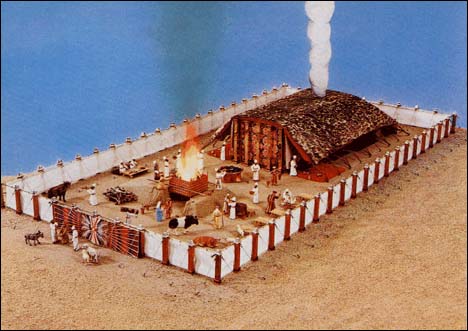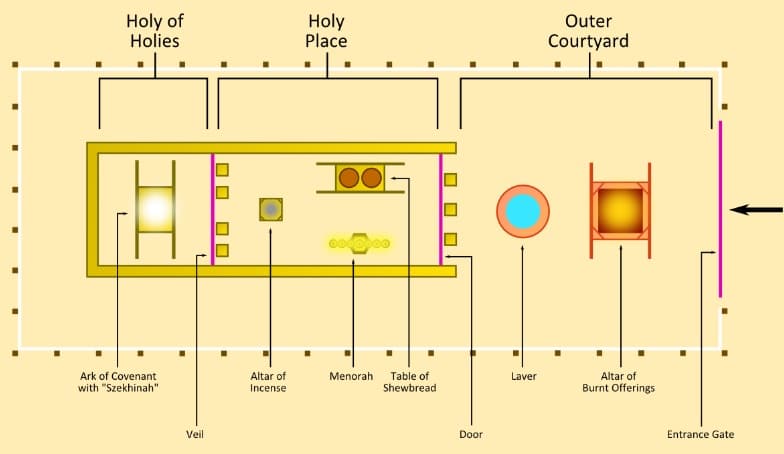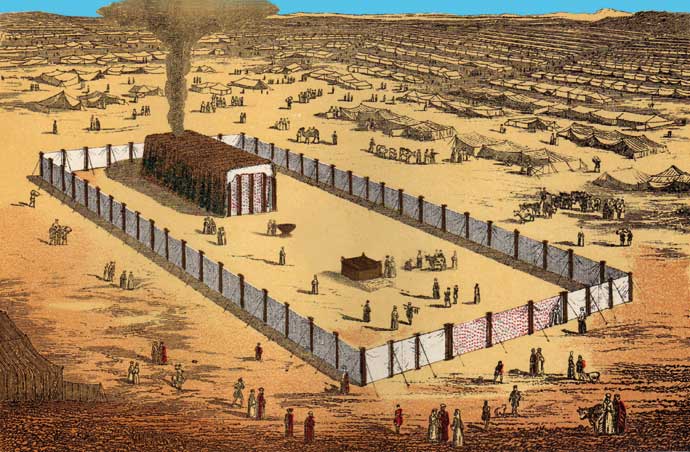 In our study, we haven’t yet entered the unique rectangle structure, which we will call the tabernacle proper. We have been both outside the courtyard and inside it, but so far – we haven’t approached the tabernacle itself.
In our study, we haven’t yet entered the unique rectangle structure, which we will call the tabernacle proper. We have been both outside the courtyard and inside it, but so far – we haven’t approached the tabernacle itself.
You, the Israelite, have taken your animal, and you have seen it sacrificed on the Bronze Altar, and you have made your exit from the courtyard. Beyond the altar and beyond the bronze basin, you could plainly see another structure, but you were not even allowed to go to that basin in the courtyard – let alone go into that unique building. Only the priests had the privilege of going in there.

The tabernacle proper was a rectangular building 15 feet wide, 45 feet long and 15 feet high. You can read about the many specifics of how it was constructed in Exodus 26 and 36. In your personal study, you can ‘go deeper’ into the study of the specifics, and you will be amazed at the rich spiritual truths you will find. But remember, this is a 101 study!
Inside the tabernacle, there were two rooms: the larger holy place (30ft long and 15ft wide) and a much smaller room called the holy of holies which was 15 feet square. It didn’t have a solid drywall or gold-plated cedar ceiling. It was made out of custom fabrics – four layers of different materials. Think of them as tarp coverings. The first layer of fabric you would see inside looking up would be:
- “The skilled craftsmen made ten curtains of finely woven linen for the Tabernacle. Then Bezalel decorated the curtains with blue, purple, and scarlet thread and with skillfully embroidered cherubim.” (Exodus 36:8 NLT)
- And then on top of that was: “He made eleven curtains of goat-hair cloth to serve as a tent covering for the Tabernacle.” (Exodus 36:14 NLT)
- The third layer: “He made a covering for the tent of rams’ skins dyed red”
- And then the fourth layer, which would be exposed to the weather – just like the roof on your house, was “a covering of porpoise skins” (Exodus 36:19NASB). Incidentally, scholars debate what the original Hebrew word means for the external layer of the tabernacle covering. Whatever it was, it seems it was water-repellant and leak-proof.

Four coverings rolled back so you can see the layers.
So let’s now go from the outside in. That rectangle tabernacle structure would not be very impressive to the human eye – the water-repellent tarp made from the hide of a sea animal! When Jesus was here on earth, did He visibly show to the human eye any particular outward beauties or anything of the majestic grandeur of who He was and where He came from? Let your heart be touched by Isaiah 53:2. And yet, inside – all the fullness of Deity dwelt in bodily form. (Colossians 2:9)
Beneath the sea animal’s rubbery hide was the layer of rams’ skins dyed red. With goat hair below it and sea animal hide above it, who would have seen Layer 3 – the rams’ skin dyed red? It wouldn’t be visible to the human eye. But could God see it? There is much about Christ that’s appreciated by God alone.
In Genesis 22 the ram was caught in a thicket by its horns. Its very glory and power led to the altar and sacrifice. In Exodus 29, the ram was prominent on the day the priests were consecrated to God and His service. So the ram is linked with consecration. But what about the rams’ skin dyed red? Blood. Death. So in this covering, we have a picture of consecration which went as far as death.
The depth of the consecration which marked the Lord Jesus when He was “obedient unto death, even the death of the cross” (Philippians 2:8), can only be fully appreciated by the eye of God. There’s something which only God can enjoy and fully appreciate in His Son. It is His heart’s devotion and consecration. Yes, we, ourselves can see evidence of the consecration that marked His holy life and we can enjoy the fruit of His life of devotion; but only God, is able to know the heart of His Son. Within that heart was undivided, unchallenged loyalty to the heart of God. There are depths to Christ and His work which we can enjoy; but there are depths which only the Father can appreciate. (1)
Immediately below the red rams’ skin tarp was the goat hair cloth. Have you ever read about the scapegoat that carried sins away into the wilderness? Leviticus 16. Also, read 2 Corinthians 5:21.
Finally, the visible ceiling was the strikingly beautiful fine linen covering – and the blue, purple and scarlet threads with the embroidered cherubim (which is the plural for cherub). How good is your memory? In lessons 4 and 5, we looked at what the fine linen represents, as well as the colours. The perfect and sinless life of Jesus (fine linen) when He stepped into humanity from Heaven (blue) – when Royalty (purple) took on poverty and shed precious blood (scarlet). This covering was draped over the top and hung down on the sides to approximately 18 inches from the ground.
As those priests looked up and all around them inside the Holy Place – they would appreciate the fine linen drapery and see its striking beauty. Today, believer-priests who are enjoying the sanctuary and moving in service within appreciate Christ in a way that others do not. Intimacy. Fellowship.
One more thing before we close this lesson: how did the priests enter the Tabernacle Proper into the Holy Place? Remember this: there were three strategically located curtains hanging in the tabernacle and its courtyard. Each one was made from fine-twined linen with embroidered threads of blue, purple and scarlet. The ‘gate of the court’ (Exodus 27:16), which we discussed in Lesson 5. Any Israelite with a sacrifice could enter here. And then there was the ‘hanging (screen/curtain) for the door or the entrance of the tent or the tabernacle proper.’ Exodus 26:36-37 Only the priests went through this entrance. And the final one is the ‘veil’ which separated the Holy Place from the Holy of Holies room. Only the High Priest himself went behind this veil into the Holy of Holies.
Besides the dimensions of the entrance, there’s a striking difference between the gate to the courtyard and the entrance to the Holy Place. The same fabric and the same colours. But the fine linen in the Holy Place also had an embroidery of cherubim on it. As you read your Bible, it seems Cherubim are associated with guarding the Holiness of God. As the priests went in and worked around the Holy Place, the embroidered cherubim would be a constant reminder of the holy character of their service.
In our walk with the Lord and as we serve Him – remember Paul’s words: “…you serve the Lord Christ.” Colossians 3:24
Lesson 10 will take us inside the beautiful Holy of Holies, where we will see gold, gold, gold. In the courtyard, we saw brass, brass, brass.
Sources:
- Dr. A.J. Higgins’ Monday Meditations


Lovely truths Peter. I’ve enjoyed the Tabernacle study for many years as well as the offerings. Keep up the good work.